After our previous article on prayer, we have done some more study on the traditions and customs that surround prayer. One of the topics that have come up in our discussion about prayer, is the use of tefillin. A lot of people wonder if the Jewish interpretation is valid. Is it valid to interpret the verse literally as they do?
We will do a more detailed study on this practice to see if it is Scriptural and how we should apply this aspect of prayer to our lives.
The Scriptures
The practice of using of tefillin is based on four Scriptures.
Exodus 13:8–9
8 “You shall tell your son on that day, saying, ‘It is because of what YHVH did for me when I came out of Egypt.’ 9 “And it shall serve as a sign to you on your hand, and as a reminder on your forehead, that the law of YHVH may be in your mouth; for with a powerful hand YHVH brought you out of Egypt.Exodus 13:16
16 “So it shall serve as a sign on your hand and as phylacteries on your forehead, for with a powerful hand YHVH brought us out of Egypt.â€Deuteronomy 6:6–9
6 “These words, which I am commanding you today, shall be on your heart. 7 “You shall teach them diligently to your sons and shall talk of them when you sit in your house and when you walk by the way and when you lie down and when you rise up. 8 “You shall bind them as a sign on your hand and they shall be as frontals on your forehead. 9 “You shall write them on the doorposts of your house and on your gates.Deuteronomy 11:18–21
18 “You shall therefore impress these words of mine on your heart and on your soul; and you shall bind them as a sign on your hand, and they shall be as frontals on your forehead. 19 “You shall teach them to your sons, talking of them when you sit in your house and when you walk along the road and when you lie down and when you rise up. 20 “You shall write them on the doorposts of your house and on your gates, 21 so that your days and the days of your sons may be multiplied on the land which YHVH swore to your fathers to give them, as long as the heavens remain above the earth.
From these four passages, we see that there is a commandment to bind the words of YHVH to your hand as a sign and as phylacteries/frontals on your forehead. Now the questions would be – Must we take these verses literally or figuratively? Judaism tells us it is literal and everybody else say it is figurativeb. Which is the correct interpretation?
Word Study
Before we dive into the phrases being used, let us first start at the lowest level by having a look at the words. What does the word “phylacteries†really mean?
The English word “phylacteries†is only used twice in the NASB translation. Once in the Tanakh, and once in the Apostolic Scriptures.
Matthew 23:5
5 “But they do all their deeds to be noticed by men; for they broaden their phylacteries and lengthen the tassels of their garments.
The Scriptures use the Greek word φυλακτήÏια – plural for “phylakterionâ€, only in this one verse. The word is derived from the Greek verb phylássÅ that means to guard or protect. 1 This has lead many to believe that people used phylacteries as some magical amulet to protect the wearer against evil. The verb phylássÅ also sometimes has a slight nuance. Then it is used in the context of “to remember.†We see the word being used in this way in the Pseudepigraphical book of THE LETTER OF ARISTEAS. Aristeas compiled this letter around 300-200 B.C.
What is the actual Hebrew word in the source text? The original Hebrew word is “טוֹטָפֹת – TôtÄpÅt.â€Â  The lemma of this word is used in Exo 13:16, Deut 6:8 and Deut 11:18. Thus, it is always in the same context. It makes it difficult for us to then determine the meaning of the word from the context. In the translation of Exodus 13:16 we find the side note “Or frontlet-bands†in the NASB. We also see some other translations of this word. The ESV translation stays consistent and uses the word “frontals†as it does in the other verses mentioned. Let us look at some other interpretations
Complete Jewish Bible
This will serve as a sign on your hand and at the front of a headband around your forehead that with a strong hand ADONAI brought us out of Egypt.â€
‎‎Lexham English Bible
And it will be as a sign on your hand and as symbolic ornaments between your eyes that with strength of hand Yahweh brought us out from Egypt.â€
‎‎New Revised Standard Version
It shall serve as a sign on your hand and as an emblem on your forehead that by strength of hand the LORD brought us out of Egypt.â€
We see a number of different interpretations here.
If we look at a similar verse, Exodus 13:9, we find a different Hebrew word being used.
Exodus 13:9
9 “And it shall serve as a sign to you on your hand, and as a reminder on your forehead, that the law of YHVH may be in your mouth; for with a powerful hand YHVH brought you out of Egypt.
In this verse the word “Zikkaron†is used in the Hebrew. This word is used more often in different contexts. We see the lemma of this word being used in the following verses:
Exodus 28:12
12 “You shall put the two stones on the shoulder pieces of the ephod, as stones of memorial for the sons of Israel, and Aaron shall bear their names before YHVH on his two shoulders for a memorial.Ecclesiastes 1:11
11 There is no remembrance of earlier things; And also of the later things which will occur, There will be for them no remembrance Among those who will come later still.Nehemiah 2:20
20 So I answered them and said to them, “The Elohim of heaven will give us success; therefore we His servants will arise and build, but you have no portion, right or memorial in Jerusalem.â€Malachi 3:16
16 Then those who feared YHVH spoke to one another, and YHVH gave attention and heard it, and a book of remembrance was written before Him for those who fear YHVH and who esteem His name.
It is interesting to note that two of these verses refer to a physical object as a sign of remembrance. The two other verses refer rather to the abstract concept of a memory. Thus, we can use the word both ways. The context needs to tell us if it is a physical or an abstract object.
In the Targums and Peshitta we see these objects referred to by the Aramaic word “tĕp̱illɩ̂n.†This is also the word that we use today to refer to the black boxes and straps that the Rabbinical Jews use during prayer. This Aramaic word is derived from either the Hebrew word for prayer ( פלל) or the word meaning “to separate / distinguish†( פלה). In modern Hebrew this is also the plural for prayer.
When did the tradition start?
If we investigate the start of the practice, it is striking to note that nowhere in the Tanakh do the writers mention this practice. Even in the post-exilic books – Nehemiah, Ezra, Malachi, etc -it is not mentioned. We find the first mention of the practice in the Letter of Aristeas3.
157 Wherefore he exhorts us to remember that the aforesaid parts are kept together by the divine power with consummate skill. For he has marked out every time and place that we may continually remember the God who rules and preserves (us). 158 For in the matter of meats and drinks he bids us first of all offer part as a sacrifice and then forthwith enjoy our meal. Moreover, upon our garments he has given us a symbol of remembrance, and in like manner he has ordered us to put the divine oracles upon our gates and doors as a remembrance of God. 159 And upon our hands, too, he expressly orders the symbol to be fastened, clearly showing that we ought to perform every act in righteousness, remembering 〈our own creation〉, and above all the fear of God. 160 He bids men also, when lying down to sleep and rising up again, to meditate upon the works of God, not only in word, but by observing distinctly the change and impression produced upon them, when they are going to sleep, and also their waking, how divine and incomprehensible the change from one of these states to the other is.
In this part of the letter, the author describes the commandments to tithe a part of the bread, and to wear tzit-tzit (Num 15:37-40.) He also refers to the tradition of fixing a mezuzah to the gates and doors. What is interesting now is that he only mentions the tradition of wearing the hand tefillin. No mention in this text of tefillin on the forehead! The experts are not in agreement on the exact dating of the letter. Most of the experts place it in the 2nd century B.C but some date it as late as the 1st century C.E.
At the compound at Qumran, the archeologists found the remains of several tefillin. In 1968, Yigael Yadin got hold of tefillin from the Judean dessert. Amongst these were the first proof ever found of head tefillin. Before only hand tefillin had been found. Inside some of these, they found the original parchments still folded in their original state.
Based on this evidence, we can conclude that the wearing of tefillin was a tradition, practiced by at least two sects of Judaism, during the Second Temple period. No earlier proof can be found in either archeological artifacts or any documents. Yet, this does not prove that it did not exist earlier. It states that we have not found it yet if it did exist!
Tefillin at Qumran
The oldest tefillin found to date was discovered in the Judean desert at the Qumran compound. The tefillin discovered at the caves have shown us that the tradition of tefillin did change over time. A good example of this is the contents and the sequence of the parchments in the head tefillin. As we know it today the head tefillin contain the following 4 paragrahps:
- Kadesh – Exo 13:1-10 – Obligation to remember the Exodus
- veHayah ki yeViaCha – Exo 13:11-16 – Obligation of transmitting the commandment to our children
- Shema – Deut 6:4-9 – Speaking about YHVH and our bond of love.
- veHaya im Shemoa – Deut: 11:13-21 – Declaring man’s responsibility towards YHVH
At the caves in Qumran, they found that the newer versions (dated to after 70 C.E.) of the tefillin contained these four paragraphs in different sequences. What is more interesting is that they found that the older versions of the tefillin had a fifth paragraph included as well. This fifth paragraph was the 10 commandments – Decalogue. They found 9 exemplars at Qumran that contained a form of the Decalogue5. This is interesting, because it indicates that the recital of the Ten Commandments was most likely part of the daily routine during the early part of the Second Temple period. In the Mishnah we see that it was tradition to recite:
- Ten Commandments
- Shema – Deut 6:4-9
- Deut 11:13-21
- Numbers 15:37-41
In the midrash found in Sifre on Deuteronomy (around 300C.E), we also see an argument on why the the Decalogue should not be “bound.†This proves that the rules around the use of tefillin were  still being discussed and agreed at a relatively late period in time. We also know that Rashi and his grandson, Rabbeinu Tam, were still arguing the sequence of the paragraphs. They had this argument during the medieval period.
still being discussed and agreed at a relatively late period in time. We also know that Rashi and his grandson, Rabbeinu Tam, were still arguing the sequence of the paragraphs. They had this argument during the medieval period.
The tefillin at Qumran has shown us, that during the second temple period there was no consistency in the use of tefillin. Some examples found contained more text than others. The sequence of the text was also not yet consistent.
The tefillin found at the Cairo Geniza also showed us something really interesting. The shape of the tefillin was also not consistent. In the geniza, they found an arm phylactery that is cylindrical.
What are modern tefillin?
Today’s tefillin consists of two leather boxes (phylacteries), attached to long black leather straps. The boxes must be exactly square. In earlier times this was not the case. People had different sizes of head tefillin1. These were normally in a rectangular shape. Thus, the habit started of making the head phylactery wider, so that people could notice it more. This is where the saying of Y’Shua came from. He was not talking about the width of the leather straps, as most people believe. He was addressing this issue of getting people to notice you head phylactery.
Matthew 23:5
5 “But they do all their deeds to be noticed by men; for they broaden their phylacteries and lengthen the tassels of their garments.
Jewish men wear the one phylactery on the forehead – shel Rosh. This box is imprinted twice with the Hebrew letter Shin, once on the side which is to the left of the wearer, and once on the opposite side. The shin on the right has four rather than the usual three prongs. This is as a reminder of the four scriptural passages contained in the four compartments. The hand phylactery contains a singular compartment with the scriptural passages in. They base this tradition on a literal interpretation of the Hebrew words in Exo 13:16. The verse use the Hebrew word “×וֹת֙ – ôt†for the hand. This word is in the singular form. The Scripture uses the word “טוֹטָפֹ֖ת – TôtÄpÅt†for the head phylactery. This word is is in the plural form of the noun. This the interpretation to have separate parchments on the head with a singular parchment on the hand.
The different groupings within Rabbinic Judaism have different ways of tying the hand tefillin. The Ashkenazic have a different set of instructions, as compared to the Sefardic, Lubavitches and Chasidic. Each have a different pattern on the sequence in which the windings are made around the middle finger and hand. The knot of the head tefillin also differs between the Askenazi and Serfardics.
The black boxes are sewn to a base of thick leather. The boxes are attached to the base with twelve stitches. These twelve stiches represent the twelve tribes.
In modern times the phylacteries are only worn during prayer. This was not the custom earlier. Phylacteries are only worn during the day and are not worn on Sabbath or any of the moedim. The hand phylactery is on first, followed by the head phylactery. After placing each of the phylactery, they say a blessing. They then recite Hosea 2:19-20, after putting on the head tefillin.
Hosea 2:19–20
19 “I will betroth you to Me forever; Yes, I will betroth you to Me in righteousness and in justice, In lovingkindness and in compassion, 20 And I will betroth you to Me in faithfulness. Then you will know YHVH.
Here is a short summary for the rules that accompany the the use tefillin according the Jewish tradition4.
- The parchments must be made of the outmost hide of a kosher animal
- The parchments must be written with permanent black ink
- The parchments must be written by an ordained Scribe.
- The parchments must be tied shut with the hair of a kosher animal
- The parchments must be placed in a perfectly square leather box
- The box of the head tefillin must be inscribed with the Hebrew letter “Shin.”
- The boxes must have a slightly wider base than the boxes
- The base must contain a opening where the straps can be put through
- The boxes must be sewn closed with thread made from the veins or sinews of a kosher animal
- The tefillin must be tied with leather straps, dyed black on the outside
- The strap of the head tefillin must be tied with a knot in the shape of the Hebrew letter “Dalet“
- The strap of the hand tefillin must be tied with a knot in the shape of the Hebrew letter “Yud“
- The hand tefillin must be put on first. It is wrapped around the fore-arm seven times. The black side must be on the outside. It must be wrapped 3 times around the middle finger.
- The head tefillin must be worn above the hairline with the knot centered at the base of the skull.
- Blessings must be said when tightening the tefillin around the arm and head.
- Tefillin are only worn during the day, every day except Shabbat and Moedim
- Tefillin must be worn by men older than 13 years. Women do not use tefillin.
The tefillin contains the three Hebrew letters “Shin“, “Dalet” and “Yud“. According to Jewish tradition, this spells the word “Shadai” – usually translated as “Almighty.”
What did Y’Shua do?
As disciples of Y’Shua, we also need to asks ourselves – what did our Master do? The only time we see any record of Y’Shua making any reference to tefillin is in Matthew 23.
Matthew 23:1–7
1 Then Y’Shua spoke to the crowds and to His disciples, 2 saying: “The scribes and the Pharisees have seated themselves in the chair of Moses; 3 therefore all that they tell you, do and observe, but do not do according to their deeds; for they say things and do not do them. 4 “They tie up heavy burdens and lay them on men’s shoulders, but they themselves are unwilling to move them with so much as a finger. 5 “But they do all their deeds to be noticed by men; for they broaden their phylacteries and lengthen the tassels of their garments. 6 “They love the place of honor at banquets and the chief seats in the synagogues, 7 and respectful greetings in the market places, and being called Rabbi by men.
In this verse, Y’Shua is addressing the hypocrisy of the Pharisees. He mentions that the broaden their phylacteries for men to notice them. Please note, during this time the size of the head tefillin was not yet standardized. People still wore different sizes. They also wore their tefillin the whole day, not only during prayer. Thus, Y’Shua is making mention of the habit of some people to make their tefillin more prominent. They did this so that people could see how righteous they are. Y’Shua does not condemn the use of tefillin in this case. Y’Shua is warning us not to do the deeds of the Pharisees but to follow the words of Moses. In the same verse He also mentions the wearing of tassels. The wearing of tassels is a Scriptural commandment.
Numbers 15:38–40
38 “Speak to the sons of Israel, and tell them that they shall make for themselves tassels on the corners of their garments throughout their generations, and that they shall put on the tassel of each corner a cord of blue. 39 “It shall be a tassel for you to look at and remember all the commandments of YHVH, so as to do them and not follow after your own heart and your own eyes, after which you played the harlot, 40 so that you may remember to do all My commandments and be holy to your Elohim.
We also find proof in the Scripture that Y’Shua did wear these tassels.
Matthew 9:20
20 And a woman who had been suffering from a hemorrhage for twelve years, came up behind Him and touched the fringe of His cloak;Matthew 14:35–36
35 And when the men of that place recognized Him, they sent word into all that surrounding district and brought to Him all who were sick; 36 and they implored Him that they might just touch the fringe of His cloak; and as many as touched it were cured.
Yet, we do not find any proof in Scripture that Y’Shua, His disciples or any of the apostles wore tefillin. This, in itself, does not prove that Y’Shua never used tefillin. It does show that the authors of the gospels did not see it as important or relevant to mention.
Should we interpret it literally?
It is clear that the question is then around the interpretation of the four Scriptures, mentioned at the beginning. Are these to be taken literally or spiritually? We do not have any verse in Scripture that makes it a clear instruction. It all depends on how we see these four Scriptures.
It has always been good practice to treat Scripture as literal. When starting any Bible study course, this will be one of the first principles to be taught. Can we also do it in this case?
Let us look at the complete picture of these verses. Let us look at them again, but now with the purpose of determining if they are literal or spiritual instructions.
Exodus 13:8–9
8 “You shall tell your son on that day, saying, ‘It is because of what YHVH did for me when I came out of Egypt.’ 9 “And it shall serve as a sign to you on your hand, and as a reminder on your forehead, that the law of YHVH may be in your mouth; for with a powerful hand YHVH brought you out of Egypt.
We all acknowledge that the commandment to celebrate Pesach, and teach our children, is something we take literal. We know that the part that states that it is me that came out of Egypt is not literal. Few of us can claim to be physically saved by YHVH from Egypt. The same arguments would also count for the verse in Exodus 13:16. We also will not take the instruction to have the law in our mouths literally.
Deuteronomy 6:6–9
6 “These words, which I am commanding you today, shall be on your heart. 7 “You shall teach them diligently to your sons and shall talk of them when you sit in your house and when you walk by the way and when you lie down and when you rise up. 8 “You shall bind them as a sign on your hand and they shall be as frontals on your forehead. 9 “You shall write them on the doorposts of your house and on your gates.
This verse starts off with a line that states that the words that YHVH command us must be on your heart. It is clear that this is not a literal instruction. To physically write YHVH’s commandments on your heart is not something that anybody should attempt to do. The next verse in Deut 11:18-21 also starts with the same instruction to have the words of YHVH impressed on your heart.
So, why do some take the commandment to be literal? The answer for this lies in the words that are being used. The first word to look at is the word “sign.â€
If we investigate the use of this Hebrew word, we see that it also refers to:
- The sun, moon and stars – Gen 1:14
- The sign YHVH put on Cain’s forehead – Gen 4:15
- The rainbow – Gen 9:12 – 17
- Circumcision – Gen 17:11
- The mountain on which YHVH called Moses – Exo 3:12
The use of the Hebrew word in Scripture normally refers to a physical sign. Other instances of this word must be interpreted literally.
The next Hebrew word being used is “reminder†– זִכָּרוֹן֙.
1. LN 29.6–29.12 memorial, commemoration, i.e., a place or object to remind one of something (Ex 28:29; Jos 4:7);
2. LN 57.125–57.141 inheritance right, formally, memorial, i.e., the right or claim to a possession based on a prior agreement (Ne 2:20), note: NIV translates “historic rightâ€;
3. LN 33.11–33.25 maxim, proverb, by-word, i.e., a brief statement easily remembered (Job 12:13);
4. LN 33.476–33.489 symbol, pagan signs, formally, remembrance, i.e., a non-verbal artifact which conveys information about the relationship of a god to his/her people (Isa 57:8);
5. LN 53.16–53.27 unit: ×žÖ´× ×—Ö¸×” זִכָּרוֹן (min·ḥÄ(h) zik·kÄ·rôn) reminder offering (Nu 5:15, 18);
6. LN 33.35–33.68 unit: סֵפֶר ×”Ö·Ö¾ זִכָּרוֹן (sē·pÌ„Ä›r hÇŽ- zik·kÄ·rôn) Book of Remembrance, i.e., a written record of historical records (Ex 17:14; Est 6:1; Mal 3:16+) 6
Here again, we see that the use of the word in Scripture refers to something physical. We see that the following are to be reminders:
- Moedim – Exo 12:14, Lev 23:24
- The written word of YHVH – Exo 17:14
- The stones on the shoulder pieces of the ephod worn by the High Priest – Exo 39:7
- Offerings – Num 5:15,18 Num 10:10
- The gold brought to the tent of meeting – Num 31:45
- The altar built after crossing the Jordan – Josh 4:7
It is interesting to note that all references point to a physical object as a reminder. Thus, if we say that we should not interpret the commandment as literal, it would be the only case in the Tanakh where we interpret it as spiritual. The words that Exodus 13:9 uses would favor the literal interpretation of the verse
The other argument that supporters of tefillin put forward is the fact that this practice was common in the Ancient Near East. It is known from archeology that other nations also had the sign of their deity on their foreheads. The sign could have been in one of many forms: a tattoo, an amulet or a piece of jewelry. Archeologists have found some proof that people in the Ancient Near East wrote the names of their deities on items of value to protect them. This included objects around the necks of animals, carvings on furniture, and jewelry that people wore around the necks and on their heads. We also know from the Scriptures that this was also done by the Israelites.
Isaiah 3:17–23
17 Therefore YHVH will afflict the scalp of the daughters of Zion with scabs, And YHVH will make their foreheads bare.†18 In that day YHVH will take away the beauty of their anklets, headbands, crescent ornaments, 19 dangling earrings, bracelets, veils, 20 headdresses, ankle chains, sashes, perfume boxes, amulets, 21 finger rings, nose rings, 22 festal robes, outer tunics, cloaks, money purses, 23 hand mirrors, undergarments, turbans and veils.
Archeologists found the oldest piece of surviving text from the Bible, in 1979, at Ketef Himmon. This site is south east of the Old City of Jerusalem. They dated these texts to around the 7th century B.C; around the last days of the Davidic monarchy. In one of the burial chambers they found two small scrolls made of pure silver. One of these scrolls was inscribed with the Aaronic blessing found in Numbers 6:23-26. These two scrolls were written in Paleo Hebrew. They had a hole in the center of the scroll, allowing the owner to wear it around the neck. It is also interesting to note that these two scrolls still contained the Tetragrammaton, “Yod Hey Vav Heyâ€, in the original Paleo Hebrew font.
Thus, we can see that the practice of wearing amulets was already practiced early by the Israelites. We also see from these findings at Ketef Himmon, that these amulets contained verses of Scripture that included the name of YHVH. But, we do not have any clear correlation between amulets, magic and tefillin. All these connections are pure speculation and interesting theories.
Conclusion
Let us summaries all the different angles we have investigated: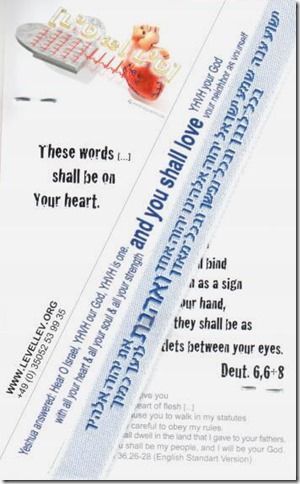
- Based on the text, the verses contain some phrase that we cannot take literally. But, it contains words that are mostly associated with physical objects.
- History shows us no use of the tefillin in the time of the Tanakh. However, this is not conclusive, as archeology cannot prove the non-existence of anything.
- We have proof that the Pharisees and the people at Qumran used tefillin during the Second Temple period by .
- The tradition of tefillin was still very fluid during the Second Temple period and started to stabilize after that.
- Y’Shua mentioned the use of tefillin. Y’Shua did not criticize the use of tefillin. But, we have no proof that He followed the practice.
We have also seen in the historical proof, that the practice of using tefillin has evolved over time. Originally, people wore tefillin the whole day, but later, due to persecution, they wore it only in the synagogue when praying. Due to the fact that the tefillin had to be carried to the synagogue, the use on Sabbath and the holy days was stopped. The form and content has also evolved over time and started to normalize only after the Second Temple period, around the time of Bar Kochba.
Thus, it is clear that the use versus do not use of tefillin cannot be conclusively argued from either point. Both sides have good points and gaps in their defense. What are we then to do?
As with all Scripture, it is crucial that you search for yourself. Seek the will of YHVH in your life with study and prayer.
A good friend of ours has created an alternative for the hand tefillin. Based on discussions with his children, they have decided that they do want to bind the words to their hands. For them, it was also important that it should be practical to do it all day, not only when praying. This led them to design a band that can be worn around the arm. The wristband is woven of high quality, durable material and contains the words of Y’Shua in Mark 12:28-31. They took these words back to the Hebrew form via Deut 6:4 and Lev 19:18 and wove it with blue into a white background. The result (as can be seen in the picture) is a band in white and blue that can be worn around the wrist. It can be made to fit almost any size wrist, light, and easy to keep clean. Last time we spoke, they were still thinking how to do something similar for the “ frontlets between your eyes†portion of the text. If you would like to get some more information on these, please contact them via www.levellev.org.
Also let me know how you interpret these Scriptures and how you have incorporated them into your daily life.
References
- Nunnally, W. E. (2000). Phylacteries. In (D. N. Freedman, A. C. Myers, & A. B. Beck, Eds.)Eerdmans dictionary of the Bible. Grand Rapids, MI: W.B. Eerdmans.
- Charles, R. H. (Ed.). (2004). Pseudepigrapha of the Old Testament (Vol. 2, p. 109). Bellingham, WA: Logos Bible Software.
- Fagen, R. S. (1992). Phylacteries. In (D. N. Freedman, Ed.)The Anchor Yale Bible Dictionary. New York: Doubleday.
- Kaplan, Aryeh. Tefillin. OU/NCSY Publications. ISBN 1-879016-06-0
- Adler, Yonathan.The Content and Order of the Scriptural Passages in Tefillin: A Reexamination of the Early Rabbinic Sources in Light of the Evidence from the Judean Desert. Published in: Halakhah in Light of Epigraphy (Journal of Ancient Judaism Supplement Series 3: eds. A.I. Baumgarten, H. Eshel, R. Katzoff and S. Tzoref: Göttingen: Vandenhoeck & Ruprecht, 2011), pp. 205–229. Retrieved from http://www.academia.edu on 16/08/2014
- Swanson, J. (1997). Dictionary of Biblical Languages with Semantic Domains : Hebrew (Old Testament). Oak Harbor: Logos Research Systems, Inc.


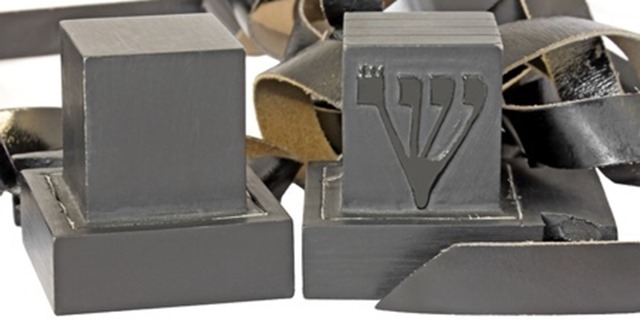
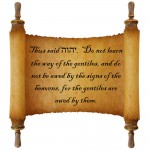
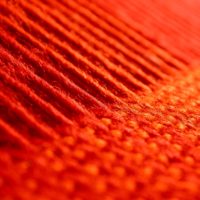
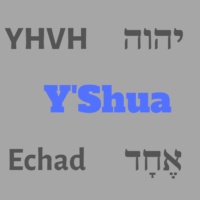



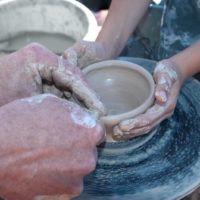

Leave a Reply to Yadria Cancel reply